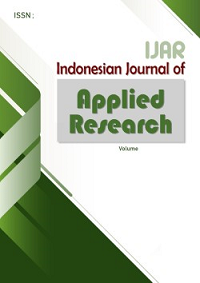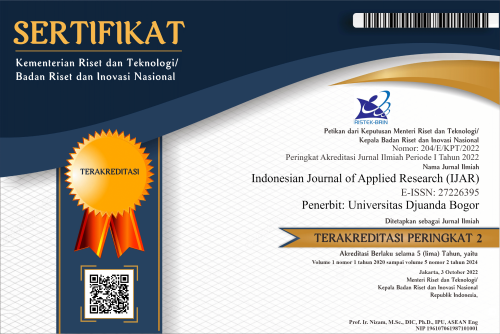Riparian Trees and Its Roles to Water Quality in Niukbaun Springs
Abstract
Riparian trees play an essential role in maintaining the quality of the springs. This research was conducted to determine riparian tree types and water quality in Niukbaun Springs, Kupang district. Tree samples were measured by using the Quadrat Sampling Technique. Meanwhile, water quality measurement included physical, chemical, and microbiological parameters. All data collected were analyzed to determine the Shannon-Wiener diversity index, tree endemism status, and gap analysis (conformance of water quality profiles with water quality standards). The results revealed that there were 11 families consisting of Anacardiaceae, Arecaceae, Bombacaceae, Dendrocnide, Elaeocarpaceae, Euphorbiaceae, Meliaceae, Moraceae, Oxalidaceae, Sapindaceae, and Verbenaceae with a total of 149 individuals. The endemism status of the 15 tree species found was 80% classified as endemic and 20% classified as exotic. From the results of the physical and chemical quality tests of water, it was found that almost all parameters met the water quality standards, except for nickel (dissolved metal), which did not meet the water quality standards. Microbiological test results revealed a type of bacteria with similar characteristics to the bacteria Proteus mirabilis, Klebsiella aerogenes, and E. coli. Human activities impact the diversity of riparian trees and the quality of water in Niukbaun Springs.
References
Ainy, N. S., Wardhana, W., & N. (2018). Struktur Vegetasi Riparian Sungai Pesanggrahan Kelurahan Lebak Bulus Jakarta Selatan Riparian Vegetation Structure in Pesanggrahan River at Lebak Bulus, South Jakarta. Bioma, 14(2), 60–69. https://doi.org/10.21009/Bioma14(2).2
Liunima, V., Banilodu, L., & Semiun, C. G. (2022). Composition and diversity of riparian vegetation of the Talau River , Belu Regency. Edubiotik: Jurnal Pendidikan, Biologi Dan Terapan, 7(02), 81–90. https://doi.org/https: //doi.org/10.33503/ebio.v7i02.2073
Mamulak, Y. I., Semiun, C. G. (2021). Contribution of riparian vegetation to water quality in spring water Oras. Indonesia Journal of Applied Research (IJAR), 2(1), 28–32. https://doi.org/https://doi.org/10.30997/ijar.v2i1.95
Oktaviani, R., & Yanuwiadi, B. (2016). Persepsi Masyarakat Terhadap Konservasi Spesies Riparian di Tepi Sungai Porong Kabupaten Sidoarjo. Jurnal Biotropika, 4(3), 81–87. https://biotropika.ub.ac.id/index.php/biotropika/article/view/411
Paramitha, I. G. A. A. P., & Kurniawan, R. (2017). Komposisi Tumbuhan Air dan Tumbuhan Riparian di Danau Sentani, Provinsi Papua. Oseanologi Dan Limnologi Di Indonesia, 2(2), 33. https://doi.org/10.14203/oldi.2017.v2i2.92
Peraturan Menteri Kesehatan Republik Indonesia Nomor 32 Tahun 2017 tentang Standar Baku Mutu Kesehatan Lingkungan dan Persyaratan Kesehatan Air Untuk Keperluan Higiene Sanitasi , Kolam Renang, Solus Per Aqua, dan Pemandian Umum.
Peraturan Republik Indonesia Nomor 22 tahun 2021 tentang Penyelenggaraan Perlindungan dan Pengelolaan Lingkungan Hidup.
Razi, T. K., & Syahputra, F. (2021). Uji Kualitas Air Sumur Dengan Menggunakan Metode Mpn (Most Probable Numbers) Di Desa Dayah Tanoh Kecamatan Glumpang Tiga Kabupaten Pidie Tahun 2020. Jurnal Real Riset, 3(2), 118. https://doi.org/10.47647/jrr
Semiun, C. G., & Lenggur, E. R. A. (2018). The Profile of Riparian Tree Grown in the Area of Water Springs in Kupang, Nusa Tenggara Timur Province Indonesia. International Journal of Sciences: Basic and Applied Research (IJSBAR), 42(5), 75–83. https://gssrr.org/index.php/JournalOfBasicAndApplied/article/view/9547
Semiun, C.G., Retnaningdyah, C. and Arisoesilaningsih, E. (2020). Structural modelling of riparian tree diversity and ecosystem degradation roles in determining the water quality of springs and its drains in East Java. J. Degrade. Min. Land Manage, 8(1), 2431–2438. https://doi.org/10.15243/jdmlm. 2020.081.2431
Sudarso, J., Wardiatno, Y., Setiyanto, D. D., & Anggraitoningsih, W. (2013). Pengaruh Aktivitas Antropogenik di Sungai Ciliwung Terhadap Komunitas Larva Trichoptera. Jurnal Manusia Dan Lingkungan, 20(1), 68–83. https://doi.org/https://doi.org/10.22146/jml.18475
Ufiza, S., Salmiati, R. H. (2018). Analisis Vegetasi Tumbuhan dengan Metode Kuadrat pada Habitus Herba di Kawasan Pegunungan Deudap Pulo Nasi Aceh Besar. Prosiding Seminar Nasional Biotik, 209–215.
Wali, W., Emiyarti, & Afu, L. O. A. (2020). Heavy Metal Content of Nickel (Ni) in Sediment and Seawater in Tapuemea Seawaters, North Konawe. Sapa Laut, 5(1), 37–47. http://ojs.uho.ac.id/index.php/jsl
Wibowo, D., Basri, B., Adami, A., Sumarlin, S., Rosdiana, R., Ndibale, W., & Ilham, I. (2020). Analisis Logam Nikel (Ni) dalam Air Laut dan Persebarannya di Perairan Teluk Kendari, Sulawesi Tenggara. Indo. J. Chem. Res., 8(2), 144–150. https://doi.org/10.30598//ijcr.2020.8-dwi
Copyright (c) 2023 Indonesian Journal of Applied Research (IJAR)

This work is licensed under a Creative Commons Attribution-ShareAlike 4.0 International License.
The Authors submitting a manuscript do so on the understanding that if accepted for publication, copyright publishing of the article shall be assigned/transferred to Indonesian Journal of Applied Research (IJAR) Universitas Djuanda as Publisher of the journal. Upon acceptance of an article, authors will be asked to complete a 'Copyright Transfer Agreement'. An e-mail will be sent to the corresponding author confirming receipt of the manuscript together with a 'Copyright Transfer Agreement' form by online version of this agreement.
Indonesian Journal of Applied Research (IJAR) Universitas Djuanda, the Editors and the Editorial Board make every effort to ensure that no wrong or misleading data, opinions or statements be published in the journal. In any way, the contents of the articles and advertisements published in the Indonesian Journal of Applied Research (IJAR) Universitas Djuanda are sole and exclusive responsibility of their respective authors and advertisers.
Remember, even though we ask for a transfer of copyright, our journal authors retain (or are granted back) significant scholarly rights as mention before.
The Copyright Transfer Agreement (CTA) Form can be downloaded here: Copyright Transfer Agreement-IJAR 2020
The copyright form should be signed electronically and send to the Editorial Office e-mail below:
Prof. Dr. Ir. Dede Kardaya, M.Si. (Editor-in-Chief)
Universitas Djuanda
Jl. Tol Jagorawi No.1, Ciawi, Kec. Ciawi, Bogor, Jawa Barat 16720
Website: http://journal.unida.ac.id/index.php/IJAR/index
Email: ijar@unida.ac.id






 This work is licensed under a
This work is licensed under a 